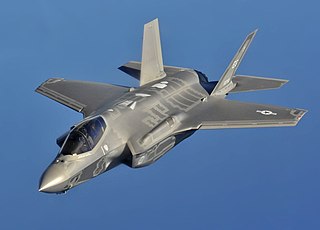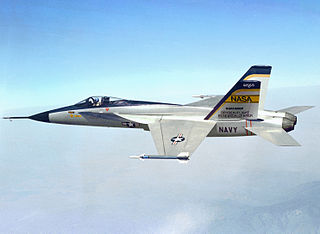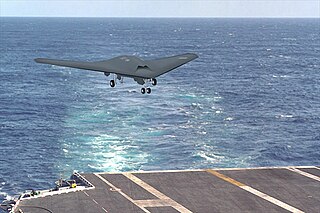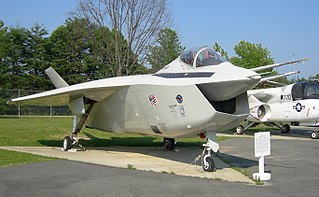
The AIM-120 Advanced Medium-Range Air-to-Air Missile, or AMRAAM, is a modern American beyond-visual-range air-to-air missile (BVRAAM) capable of all-weather day-and-night operations. Designed with a 7-inch (180mm) diameter form-and-fit factor, and employing active transmit-receive radar guidance instead of semi-active receive-only radar guidance, it has the advantage of being a fire-and-forget weapon when compared to the previous generation Sparrow missiles. When an AMRAAM missile is launched, NATO pilots use the brevity code Fox Three.

The McDonnell Douglas F-15 Eagle is an American twin-engined, all-weather tactical fighter aircraft designed by McDonnell Douglas to gain and maintain air supremacy in all aspects of aerial combat. Following reviews of proposals, the United States Air Force selected McDonnell Douglas's design in 1967 to meet the service's need for a dedicated air-superiority fighter. The Eagle first flew in July 1972, and entered service in 1976. It is among the most successful modern fighters, with over 100 victories and no losses in aerial combat, with the majority of the kills by the Israeli Air Force.

The Lockheed Martin F-35 Lightning II is a family of single-seat, single-engine, all-weather stealth multirole fighters. The fifth-generation combat aircraft is designed to perform ground-attack and air-superiority missions. It has three main models: the F-35A conventional takeoff and landing (CTOL) variant, the F-35B short take-off and vertical-landing (STOVL) variant, and the F-35C carrier-based catapult-assisted take-off but arrested recovery (CATOBAR) variant. The F-35 descends from the Lockheed Martin X-35, the winning design of the Joint Strike Fighter (JSF) program. It is built by Lockheed and many subcontractors, including Northrop Grumman, Pratt & Whitney, and BAE Systems.

The Northrop YF-17 was a prototype lightweight fighter aircraft designed for the United States Air Force's Lightweight Fighter (LWF) technology evaluation program. The LWF was initiated because many in the fighter community believed that aircraft like the F-15 Eagle were too large and expensive for many combat roles. The YF-17 was the culmination of a long line of Northrop designs, beginning with the N-102 Fang in 1956, continuing through the F-5 family.

The Boeing X-32 is a concept demonstrator aircraft that was designed for the Joint Strike Fighter contest. It lost to the Lockheed Martin X-35 demonstrator, which was further developed into the Lockheed Martin F-35 Lightning II.

The Boeing F/A-18E and F/A-18F Super Hornet are twin-engine, carrier-capable, multirole fighter aircraft variants based on the McDonnell Douglas F/A-18 Hornet. The F/A-18E single-seat and F/A-18F tandem-seat variants are larger and more advanced derivatives of the F/A-18C and D Hornet. The Super Hornet has an internal 20 mm M61 rotary cannon and can carry air-to-air missiles and air-to-surface weapons. Additional fuel can be carried in up to five external fuel tanks and the aircraft can be configured as an airborne tanker by adding an external air refueling system.

Air Education and Training Command (AETC) was established 1 July 1993, with the realignment of Air Training Command and Air University. It is one of the U.S. Air Force's ten major commands and reports to Headquarters, United States Air Force.

The Boeing X-46 was a proposed unmanned combat air vehicle (UCAV) that was to be developed in conjunction with the U.S. Navy and DARPA as a naval carrier-based variant of the Boeing X-45 UCAV being developed for the U.S. Air Force. Two contracts for technology demonstrators were awarded in June 2000, to Boeing for the X-46A and to Northrop Grumman for the X-47A.

The Lightweight Fighter (LWF) program was a United States Air Force technology evaluation program initiated in the late 1960s by a group of officers and defense analysts known as the "Fighter Mafia". It was spurred by then-Major John Boyd's Energy-Maneuverability (E-M) theory, which indicated that excessive weight would have severely debilitating consequences on the maneuverability of an aircraft. Boyd's design called for a light-weight fighter with a high thrust-to-weight ratio, high maneuverability, and a gross weight of less than 20,000 lb (9,100 kg), half that of its counterpart, the F-15 Eagle. It resulted in the development of the General Dynamics YF-16 and Northrop YF-17. Late in the program, in 1974, with the promise of European sales, the Air Force changed the program name to Air Combat Fighter (ACF), and committed to purchasing 650 models of the YF-16, adopted as the F-16 Fighting Falcon. The U.S. Navy adopted a modified version of the YF-17 as the F/A-18 Hornet.

The DARPA Falcon Project is a two-part joint project between the Defense Advanced Research Projects Agency (DARPA) and the United States Air Force (USAF) and is part of Prompt Global Strike. One part of the program aims to develop a reusable, rapid-strike Hypersonic Weapon System (HWS), now retitled the Hypersonic Cruise Vehicle (HCV), and the other is for the development of a launch system capable of accelerating an HCV to cruise speeds, as well as launching small satellites into Earth orbit. This two-part program was announced in 2003 and continued into 2006.

Joint Strike Fighter (JSF) is a development and acquisition program intended to replace a wide range of existing fighter, strike, and ground attack aircraft for the United States, the United Kingdom, Turkey, Italy, Canada, Australia, the Netherlands, and their allies. After a competition between the Boeing X-32 and the Lockheed Martin X-35, a final design was chosen based on the X-35. This is the F-35 Lightning II, which will replace various tactical aircraft, including the US F-16, A-10, F/A-18A-D, AV-8B and British Harrier GR7, GR9s, and Tornado GR4. The projected average annual cost of this program is $12.5 billion with an estimated program life-cycle cost of $1.1 trillion.

A fifth-generation jet fighter is a jet fighter classification used around the world that encompasses the fighter technologies developed during the first part of the 21st century. As of 2019 these are the most advanced aircraft. The exact characteristics of fifth-generation jet fighters are controversial and vague, with Lockheed Martin defining them as having all-aspect stealth even when armed, low-probability-of-intercept radar (LPIR), high-performance airframes, advanced avionics features, and highly integrated computer systems capable of networking with other elements within the battlespace for situation awareness.
A sixth-generation jet fighter is a conceptualized class of fighter aircraft design more advanced than the fifth-generation jet fighters that are currently in development. Several countries have announced the development of a sixth-generation aircraft program, including the United States, United Kingdom, Russia, Japan, Germany, and France.
Paul Bevilaqua is an aeronautics engineer at Lockheed Martin in California. In 1990, he invented the lift fan for the Joint Strike Fighter F-35B along with fellow Skunk Works engineer Paul Shumpert.

The T-X program has been established to enable the United States Air Force to buy a new two-seat jet trainer for fast-jet training to replace the Northrop T-38 Talon; the average age of the T-38 fleet is over 50 years. About 350 aircraft are expected to be ordered to replace the T-38, but further purchases could push the overall purchase to over 1,000. The notional in-service date for the replacement trainer was 2017, but shrinking budgets have pushed initial operating capability (IOC) to around 2023. The program was expected to begin in FY 2017.

The AGM-158C LRASM is a stealthy anti-ship cruise missile under development for the United States Air Force and United States Navy by the Defense Advanced Research Projects Agency (DARPA). The LRASM was intended to pioneer more sophisticated autonomous targeting capabilities than the U.S. Navy's current Harpoon anti-ship missile, which has been in service since 1977.
Airborne Launch Assist Space Access, or DARPA ALASA is a canceled program of the US defense technology agency DARPA "designed to produce a rocket capable of launching a 100-pound satellite into low Earth orbit for less than $1 million." The program was conceived, then announced in 2011, and funded development work began in 2012. The project was terminated in late 2015.
The DARPA XS-1 is an experimental spaceplane/booster with planned capability to deliver small satellites into orbit for the U.S. Military. It is reported to be designed to be reusable as frequently as once a day, with a stated goal of doing so for 10 days straight. The XS-1 is intended to directly replace the "first stage" of a multistage rocket that will be capable of hypersonic flight at suborbital altitude, enabling one or more expendable upper stages to separate and deploy a payload into low Earth orbit. The XS-1 would then return to Earth, where it could ostensibly be serviced fast enough to repeat the process at least once every 24 hours.
















